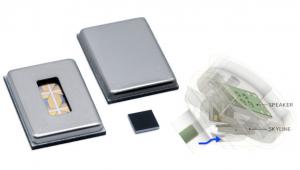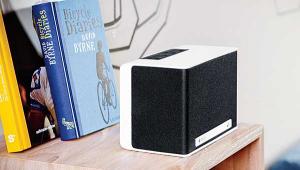Face Off: Surround-Speaker-Configuration Wars
Lightsabers swirl all around, machines explode to the side, and lasers come from directly behind you. If you saw The Phantom Menace in a Dolby Digital Surround EX-equipped theater, you heard one of the more spatially realistic soundtracks recorded to date. Now, that same technology has entered the home market under the moniker THX Surround EX (non-THX-certified products might refer to a similar process as 6.1), and a familiar question returns to haunt us: Should you use dipole or monopole (also known as direct-radiating) loudspeakers for the back channel? This time around, the question comes with a new twist: Should you use one or two speakers for this channel? Willing to conquer any challenge and answer any question, we at Home Theater took it upon ourselves to test various speaker configurations. After describing the process itself and the advantages and disadvantages of dipole and monopole speakers, we'll let you know what our panel of judges thought of the various options.
 To begin with, you've probably heard the story of Surround EX's origins. If not, the basic gist is that Lucasfilm's Gary Rydstrom, sound designer for The Phantom Menace, asked if there was any way to get more flexibility out of the existing 5.1 digital surround sound formats. Sure, having two separate surround channels was cool for directional effects traveling from front to back left, but it didn't allow for a seamless transfer of sound from, say, surround left to surround right. Engineers at THX and Dolby came up with the Surround EX system as a means of adding a sixth channel within the existing 5.1 system: a rear, center signal that's officially called the "surround back" channel. This format is sometimes (although inappropriately) referred to as 6.1. Surround EX is completely compatible with existing 5.1 digital systems because it's still a 5.1 system itself (hence the reason that we dislike the 6.1 denotation). Surround back information is matrix-recorded, in mono, in both the left surround and right surround channels of the 5.1 soundtrack and is not a discrete channel. This process is similar to how the center front channel in a Dolby Pro Logic system is recorded. When the 5.1 EX soundtrack is decoded and played back in a system without Surround EX, the information is directed through the left and right surround channels. A Surround EX processor, however, will decode and steer this information to the surround back channel. THX Surround EX brings this process to the home theater environment on titles like Austin Powers: The Spy Who Shagged Me and The Haunting, which are recorded in EX and have been released on DVD. As we found in last month's review of the Lexicon MC-1 pre/pro, Surround EX offers considerable advantages when used with the appropriate software. It also adds new dimensions of complexity to system setup.
To begin with, you've probably heard the story of Surround EX's origins. If not, the basic gist is that Lucasfilm's Gary Rydstrom, sound designer for The Phantom Menace, asked if there was any way to get more flexibility out of the existing 5.1 digital surround sound formats. Sure, having two separate surround channels was cool for directional effects traveling from front to back left, but it didn't allow for a seamless transfer of sound from, say, surround left to surround right. Engineers at THX and Dolby came up with the Surround EX system as a means of adding a sixth channel within the existing 5.1 system: a rear, center signal that's officially called the "surround back" channel. This format is sometimes (although inappropriately) referred to as 6.1. Surround EX is completely compatible with existing 5.1 digital systems because it's still a 5.1 system itself (hence the reason that we dislike the 6.1 denotation). Surround back information is matrix-recorded, in mono, in both the left surround and right surround channels of the 5.1 soundtrack and is not a discrete channel. This process is similar to how the center front channel in a Dolby Pro Logic system is recorded. When the 5.1 EX soundtrack is decoded and played back in a system without Surround EX, the information is directed through the left and right surround channels. A Surround EX processor, however, will decode and steer this information to the surround back channel. THX Surround EX brings this process to the home theater environment on titles like Austin Powers: The Spy Who Shagged Me and The Haunting, which are recorded in EX and have been released on DVD. As we found in last month's review of the Lexicon MC-1 pre/pro, Surround EX offers considerable advantages when used with the appropriate software. It also adds new dimensions of complexity to system setup.
As it is, the debate rages on about whether to use dipole or monopole speakers for the surround channels in a 5.1 system. Although some users like the directivity of monopole speakers, THX and Home Theater have traditionally recommended dipole speakers as the better choice for the majority of installations. Now, in addition to the monopole/dipole debate, we have to figure out if we should use one or two speakers for the surround back channel. After all, there's only one signal, yet THX recommends that you use two additional dipole speakers in the rear to emulate the array of rear speakers found in commercial theaters. Are they right? Or would two side and one or two rear monopole speakers create enough of an array to work better than dipoles?
To help with the testing, I intentionally assembled a group of friends and coworkers who have no reviewing experience. I wanted to know what the average user would prefer. Our first panelist, Brandon Dahl, works by day as an accountant for Sony, but he's an avid movie fan and spends plenty of evenings in the better local theaters. Our next panelist, Jason Koehler, is both an electrical engineer and an accomplished musician. Having recorded several albums with his own band, Jason has a keen ear. Last but not least is John Martorano, Cordero Studios' photography assistant/whipping boy and professional kayaker; John has no home theater experience whatsoever. (Although we don't understand this, we'll forgive him.) I also participated, but my job was mainly to manage the operation, since I knew which speakers were being used in which setup. For everyone else, the test was blind.
 Of course, when I first thought about comparing various dipole/monopole configurations, I was hesitant about the amount of speaker schlepping that would be involved. I'd already figured out the electronics: the Lexicon MC-1 with the THX Surround EX upgrade played through Parasound and B&K amplifiers. However, the thought of exchanging as many as four monopole speakers for dipole speakers a bunch of different times, with all the speakers needing to be nearly identical to the front speakers, didn't excite me. Thankfully, around test time, audio editor Clint Walker and I had to stop by M&K Sound's factory to check out the S-150P THX speaker he reviewed last month. While touring the assembly line, M&K's vice president, Chuck Back, pointed out a professional speaker that was the answer to all my prayers: the MPS-2525. This THX-certified chameleon is identical to the acclaimed S-150P, with the addition of dual 5.25-inch drivers on either side. Flip the connections on the back, and the speaker can play in monopole, dipole, or even tripole mode. No speaker schlepping. Awesome. By the time you read this, a consumer version of this speaker should be available, called the Surround-250 ($1,399 each). Since the Surround-250's driver array is identical to that of the
Of course, when I first thought about comparing various dipole/monopole configurations, I was hesitant about the amount of speaker schlepping that would be involved. I'd already figured out the electronics: the Lexicon MC-1 with the THX Surround EX upgrade played through Parasound and B&K amplifiers. However, the thought of exchanging as many as four monopole speakers for dipole speakers a bunch of different times, with all the speakers needing to be nearly identical to the front speakers, didn't excite me. Thankfully, around test time, audio editor Clint Walker and I had to stop by M&K Sound's factory to check out the S-150P THX speaker he reviewed last month. While touring the assembly line, M&K's vice president, Chuck Back, pointed out a professional speaker that was the answer to all my prayers: the MPS-2525. This THX-certified chameleon is identical to the acclaimed S-150P, with the addition of dual 5.25-inch drivers on either side. Flip the connections on the back, and the speaker can play in monopole, dipole, or even tripole mode. No speaker schlepping. Awesome. By the time you read this, a consumer version of this speaker should be available, called the Surround-250 ($1,399 each). Since the Surround-250's driver array is identical to that of the
S-150P, I used the latter for the front LCR channels, along with an MX-350 THX subwoofer for bass. There was a substantial level difference between the direct-radiating and dipole surround modes on the Surround-250; so, after each speaker change, levels were readjusted.




















































